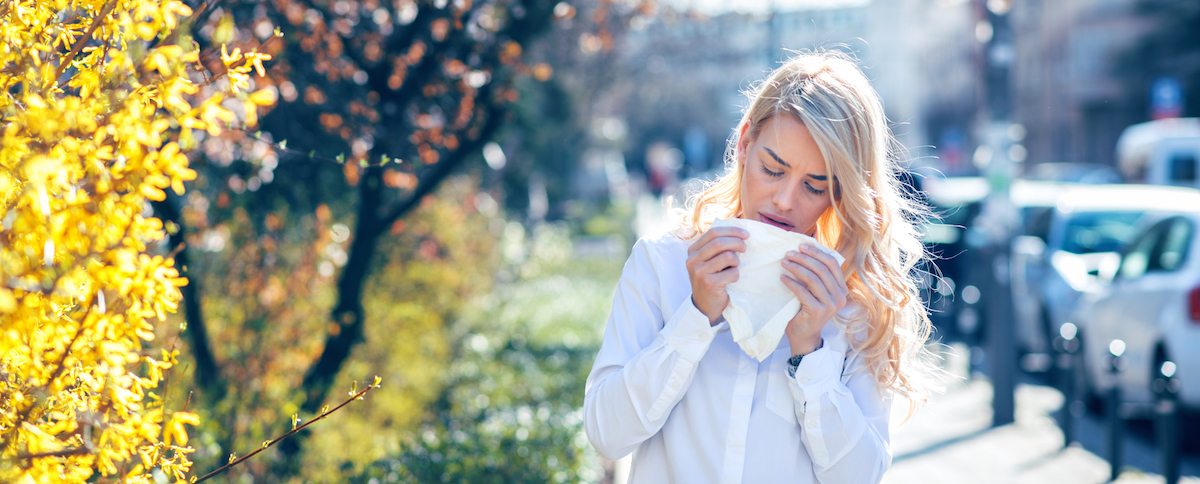Connecticut has three of the nation’s worst cities for people with seasonal allergies this spring, according to new rankings by the Asthma and Allergy Foundation.
Hartford, New Haven and Bridgeport are ranked in both Most Challenging Places to Live With Allergies for Spring 2022 and Worst U.S. Cities for Allergies, according to the annual report that analyzes pollen scores, allergy medication use and other data. Hartford is rated fourth, New Haven fifth and Bridgeport eighth in the spring rankings of Top Allergy Capitals.
“Climate change has caused the growing seasons to get longer and warmer, leading to higher pollen counts in both spring and fall,” says the foundation in the report, called 2022 Allergy Capitals: The Most Challenging Places to Live With Allergies.
With spring arriving March 20 — your itchy eyes and runny nose probably already knew it was coming — here are the 20 worst cities for allergy sufferers:
Most Challenging Places to Live With Allergies for Spring 2022
- Scranton, Pennsylvania
- Richmond, Virginia
- Wichita, Kansas
- Hartford
- New Haven
- Oklahoma City
- Albany, New York
- Bridgeport
- McAllen, Texas
- Springfield, Massachusetts
- Buffalo, New York
- Columbia, South Carolina
- San Antonio, Texas
- Dayton, Ohio
- Syracuse, New York
- Des Moines, Iowa
- Memphis, Tennessee
- Allentown, Pennsylvania
- Miami
- Jacksonville, Florida
Worst U.S. Cities for Allergies
- Scranton, Pennsylvania
- Wichita, Kansas
- McAllen, Texas
- Richmond, Virginia
- San Antonio, Texas
- Oklahoma City
- Hartford
- Buffalo, New York
- New Haven
- Albany, New York
- Bridgeport
- Springfield, Massachusetts
- Dayton, Ohio
- Columbia, South Carolina
- El Paso, Texas
- Syracuse, New York
- Des Moines, Iowa
- Miami
- Memphis, Tennessee
- Las Vegas
Texas, Connecticut and New York each have three cities that made the top 20 worst cities for allergy sufferers.
Allergy Triggers: Pollen and Outdoor Mold
Ragweed, the rogue plant that infiltrates our gardens and boundaries each year, is best known as a menace to allergy sufferers. A single ragweed plant can produce more than 1 billion grains of pollen each season. Ragweed is responsible for an estimated 100 million tons of pollen in the United States each year.
Outdoor mold, another allergy trigger, peaks in July through late summer yet persists in fall by growing on fallen leaves, soil and compost piles. Mold also thrives indoors in humid conditions. For many Connecticut homeowners, that makes a basement humidifier mandatory in the summer and early fall. But mold spores can also thrive in the dampness of a bathroom or kitchen sink area.
Most people know the symptoms as hay fever — sneezing, stuffy nose, sinus pressure, watery eyes and itchy eyes, nose and even roof of the mouth — but the medical term is allergic rhinitis. Besides ragweed and mold spores, triggers include pollens from trees, grasses and other weeds. It’s not just pollen from local plants. Once airborne, pollen can travel hundreds of miles. (Greetings, Ohio allergens!) Some people are also sensitive to dust mites, which populate the house in the humid summer before getting whipped into the air when you turn on the heat for the first time in the fall.
The sneezing, runny nose, congestion and itchy, watery eyes are more than an inconvenience. Sometimes allergy sufferers don’t know whether they’re suffering from seasonal allergies, a nasty cold or even asthma that might require a doctor’s attention. Unfortunately, your immune system isn’t doesn’t know, either. Your body can’t distinguish an actual infection from a cold and the symptoms caused by harmless pollen or mold. It treats inflammation in the nose and sinus the same: It releases cytokines to counteract an infection, even if one doesn’t exist.
In some cases, cytokines’ interaction with the nervous system and brain can affect a person’s mood. Lack of clarity, or brain fog, is an unmeasurable but common reaction, say allergy sufferers.
“As far as telling the difference between allergy and virus,” says Dr. Jason Kurtzman of the Hartford HealthCare Medical Group at Charlotte Hungerford Hospital in Torrington, “it’s often hard due to overlap of symptoms. If the primary symptoms are itchy eyes, nasal congestion, postnasal drip, that is more likely allergy. If there is also fatigue or low-grade fever I’m more likely to say virus. Both can have sore throat and cough, but again I’m more likely to link those to viral illnesses. Ultimately, we treat both very similarly.”
An allergist can determine exactly what causes your allergy symptoms by exposing your skin to specific allergens, pricking it, then checking for a reaction such as a small, itchy bump. That kind of reaction means you’re allergic. A blood test also might help. Allergen immunotherapy, commonly known as allergy shots, then can provide relief for many people without medication. The shots contain a small amount of a specific allergen to stimulate your immune system without causing an actual itchy-watery-congested reaction.
Help yourself by:
- Showering at night so you don’t bring pollen picked up during the day into your bed.
- Knowing when pollen is at its highest levels: check your favorite pollen-tracker app or
- Close windows in the home and car on days with high pollen counts.
- Start taking your medication, whether prescription or over-the-counter, before the allergy season starts.
- Clean your pets frequently: They’re carriers of dander, pollen (if they go outside) and other allergens.
- Do not dry your clothes outdoors.
- Remove decaying leaves from gutters and around the yard.
Sinus Relief
Dr. Peter Gates, a primary care provider with Hartford HealthCare Medical Group’s office in Waterford, suggests the following for relief if you’re feeling pressure in your face and sinuses:
- Use over-the-counter saline spray to rinse the pollens and mucous out of your sinuses. You can do this two to three times a day.
- Try other irrigation devices like a Neti pot to rinse out your sinuses and keep the mucous membrane moist. With this special device, you pour distilled water into one nostril. It then flows into your other nostril to flush both.
- Inhale steam from a shower or by boiling a pot of water on the stove and breathing in the steam that comes off of it. The steam can relieve pressure by opening up the nasal passages.
- Stay hydrated. Keeping your body – and mucous membranes in your sinuses – hydrated can help them work properly.
“Sinus pressure can often be a migraine variant, so it’s important to monitor the symptoms to see if they worsen,” says Dr. Gates.
If you feel progressively worse even after home remedies or experience disabling pain, nausea, vomiting or vision changes, seek professional care.
“Persistent pressure can be caused by severe allergies, infections or polyps, all of which require the help of a primary care provider,” says Dr. Gates.
To view the full report by the Asthma and Allergy Foundation, click here.
Susan McDonald contributed to this report.




